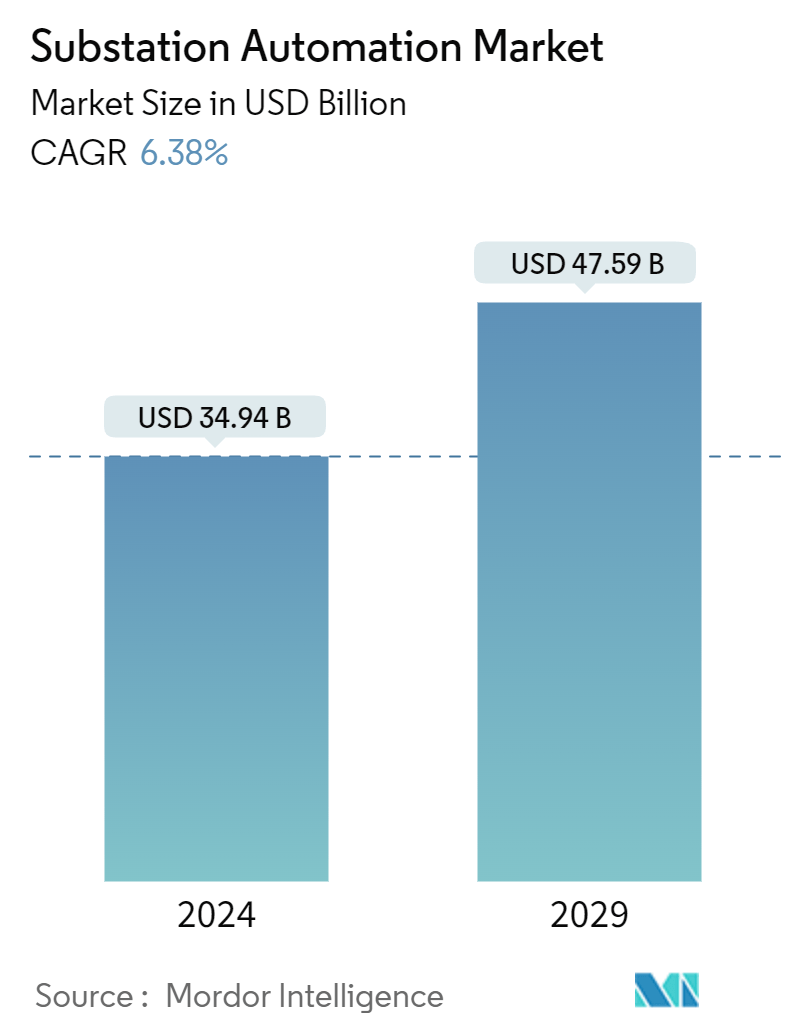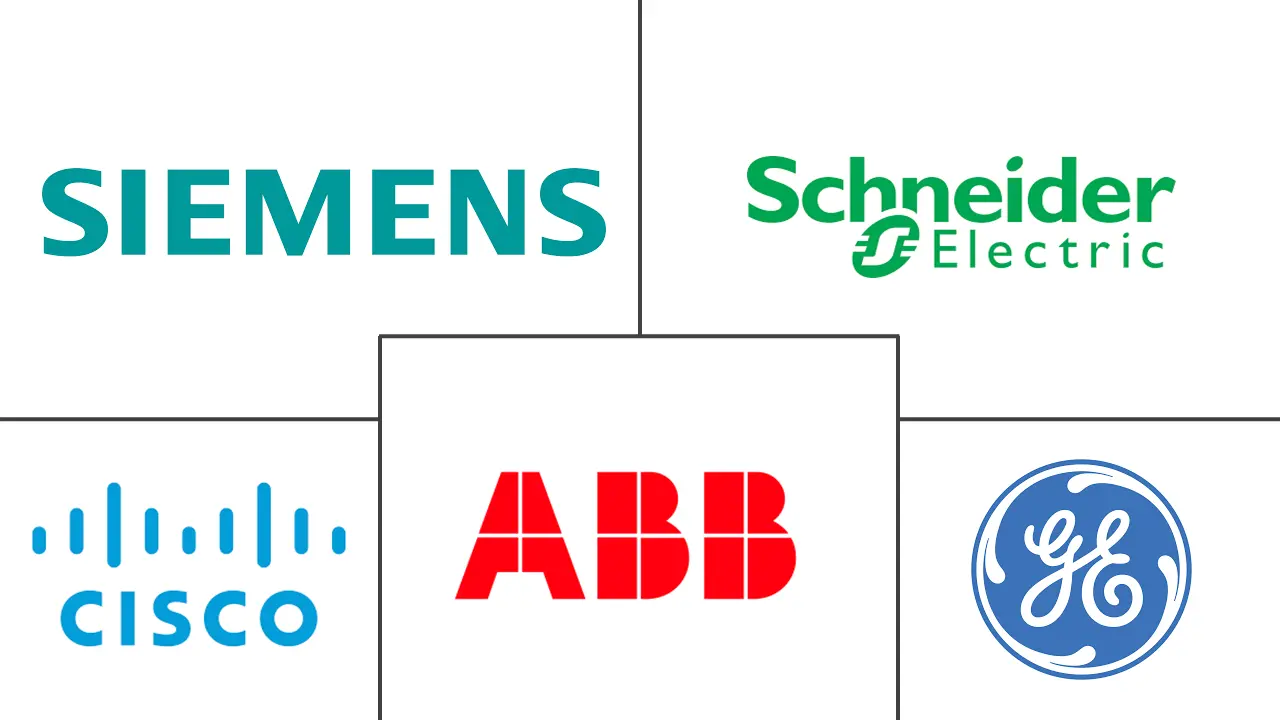Market Size of Substation Automation Industry

| Study Period | 2019 - 2029 |
| Market Size (2024) | USD 34.94 Billion |
| Market Size (2029) | USD 47.59 Billion |
| CAGR (2024 - 2029) | 6.38 % |
| Fastest Growing Market | Asia Pacific |
| Largest Market | North America |
| Market Concentration | Low |
Major Players
*Disclaimer: Major Players sorted in no particular order |
Substation Automation Market Analysis
The Substation Automation Market size is estimated at USD 34.94 billion in 2024, and is expected to reach USD 47.59 billion by 2029, growing at a CAGR of 6.38% during the forecast period (2024-2029).
- A substation automation system is usually referred to as a collection of hardware and software components integrated to control or monitor an electrical system, both locally and remotely. Substation automation systems are also used to automate tedious, repetitive, and error-prone activities to increase the overall productivity and efficiency of the comprehensive system.
- Substation automation provides protection, control, automation, monitoring, and communication capabilities as a part of a comprehensive substation control and monitoring solution. A substation layout should be clean so that the user can eliminate entire writing racks and cabinets or make them much smaller depending on how the user handles their I/Os to the IEDs (intelligent electronic devices). High-speed microprocessor-based remote terminal units or smart electronic devices are used for substation automation and protection.
- A smart grid is an electricity network that employs digital and other advanced technologies to monitor and manage electricity transport from all generation sources to meet the electricity needs of end users. To operate every system component as efficiently as possible, smart grids coordinate the needs and capabilities of all generators, grid operators, end users, and electricity market stakeholders. This maximizes system reliability, resilience, flexibility, and stability while minimizing costs and environmental impacts.
- The surge in demand for electricity is supported by factors such as the increasing propensity of consumers to low-carbon alternatives to traditional products, such as heat pumps and electric vehicles. Furthermore, companies operating in heavily polluting industries, including steel, plastics and polymers, and transportation, are also looking for electrification to enhance sustainability.
- Although the demand for substation automation is growing, cost continues to remain among the major challenging factors for the market’s growth. For instance, installing a full-scale automation system in a substation requires significant initial investment considering the large number of components being used, including SCADA, sensors, RTUs, IEDs, HMIs, servers, etc.
- In September 2023, Moxa introduced the new MGate5119 Series IEC 61850 gateway, simplifying system integrations and enhancing communication security for power substations. This substation gateway provides DNP3/IEC 101/IEC 104/Modbus-to-IEC 61850 protocol conversions, easy-to-use functions to simplify configuration and troubleshooting, security-hardened features based on the IEC 62443 and NERC CIP standards, and a protocol encryption function to enhance communication security. With these features, the MGate5119 Series IEC 61850 gateway is perfect for substation retrofit projects.
Substation Automation Industry Segmentation
Substation automation includes using data from intelligent electronic devices (IEDs) to control and automate functions within the substation. It also allows remote users to send control commands to power system devices. The features of substation automation include monitoring and controlling substation devices with the help of two-way communications through remote access and modules, such as intelligent electronic devices (IEDs). The goal is to control and monitor the substation instruments to reduce the incidence and duration of power outages.
The substation automation market is segmented by type (transmission and distribution), module (intelligent electronic devices [IED], remote terminal unit [RTU], bay control unit [BCU], and supervisory control and data acquisition [SCADA]), communication (wired and wireless), stage (retrofit and new), end user (utility and industry), and geography (North America, Europe, Asia-Pacific, and Latin America, and the Middle East and Africa). The report offers market sizes and forecasts for all the above segments in value terms (USD).
| By Type | |
| Transmission | |
| Distribution |
| By Module | |
| Intelligent Electronic Devices (IED) | |
| Remote Terminal Unit (RTU) | |
| Bay Control Unit (BCU) | |
| Supervisory Control and Data Acquisition (SCADA) |
| By Communication | |
| Wired | |
| Wireless |
| By Stage | |
| Retrofit | |
| New |
| By End User | |
| Utility | |
| Industry |
| By Geography*** | |
| North America | |
| Europe | |
| Asia | |
| Australia and New Zealand | |
| Latin America | |
| Middle East and Africa |
Substation Automation Market Size Summary
The substation automation market is poised for significant growth, driven by the increasing demand for efficient power management solutions globally. As energy consumption surges, the need for advanced substation automation systems becomes critical to manage and deliver power effectively. These systems offer comprehensive control, monitoring, and communication capabilities, enhancing the reliability and safety of power distribution. The transition towards smarter grids is fueled by the desire to reduce operational costs and meet regulatory requirements, such as those set by the North American Electric Reliability Corporation. The integration of renewable energy sources and the deployment of innovative grid communication technologies further propel the market, as they enable predictive data management and improved security.
The market landscape is highly competitive, with key players investing in research and development to innovate and expand their product offerings. Strategic partnerships and collaborations are common, as companies aim to advance low-carbon and efficient energy solutions. Notable developments include the expansion of digital substation facilities and the deployment of digital substations to enhance grid reliability. The market's growth is also supported by government initiatives and investments in smart city projects, which emphasize the importance of substation automation in modernizing energy infrastructure. As the demand for reliable and efficient power systems continues to rise, the substation automation market is expected to experience robust expansion in the coming years.
Substation Automation Market Size - Table of Contents
-
1. MARKET INSIGHTS
-
1.1 Market Overview
-
1.2 Industry Attractiveness - Porter's Five Forces Analysis
-
1.2.1 Bargaining Power of Suppliers
-
1.2.2 Bargaining Power of Buyers
-
1.2.3 Threat of New Entrants
-
1.2.4 Threat of Substitutes
-
1.2.5 Intensity of Competitive Rivalry
-
-
1.3 Industry Value Chain Analysis
-
1.4 Impact of COVID-19 Aftereffects and Other Macroeconomic Factors on the Market
-
-
2. MARKET SEGMENTATION
-
2.1 By Type
-
2.1.1 Transmission
-
2.1.2 Distribution
-
-
2.2 By Module
-
2.2.1 Intelligent Electronic Devices (IED)
-
2.2.2 Remote Terminal Unit (RTU)
-
2.2.3 Bay Control Unit (BCU)
-
2.2.4 Supervisory Control and Data Acquisition (SCADA)
-
-
2.3 By Communication
-
2.3.1 Wired
-
2.3.2 Wireless
-
-
2.4 By Stage
-
2.4.1 Retrofit
-
2.4.2 New
-
-
2.5 By End User
-
2.5.1 Utility
-
2.5.2 Industry
-
-
2.6 By Geography***
-
2.6.1 North America
-
2.6.2 Europe
-
2.6.3 Asia
-
2.6.4 Australia and New Zealand
-
2.6.5 Latin America
-
2.6.6 Middle East and Africa
-
-
Substation Automation Market Size FAQs
How big is the Substation Automation Market?
The Substation Automation Market size is expected to reach USD 34.94 billion in 2024 and grow at a CAGR of 6.38% to reach USD 47.59 billion by 2029.
What is the current Substation Automation Market size?
In 2024, the Substation Automation Market size is expected to reach USD 34.94 billion.

